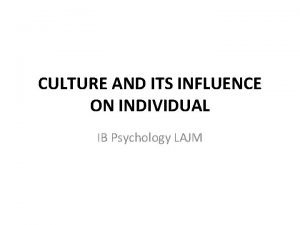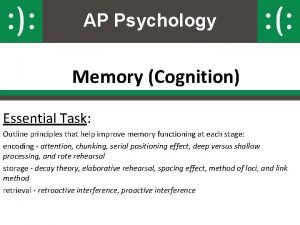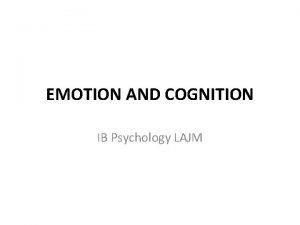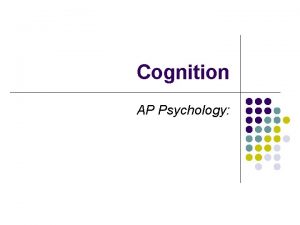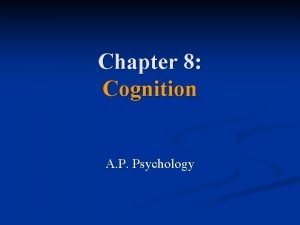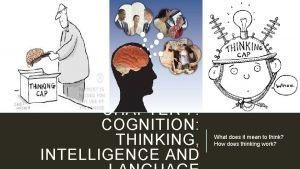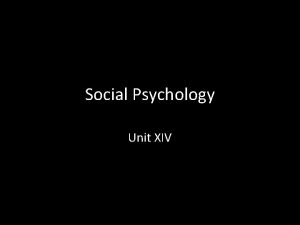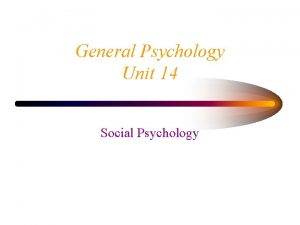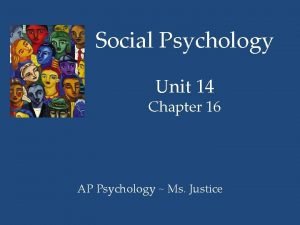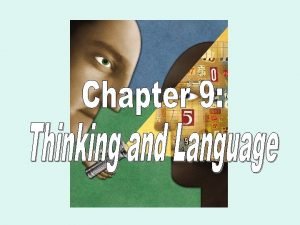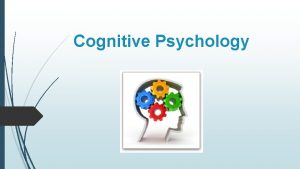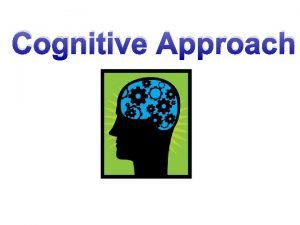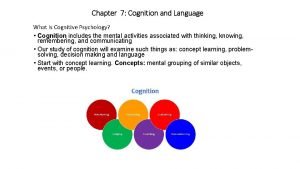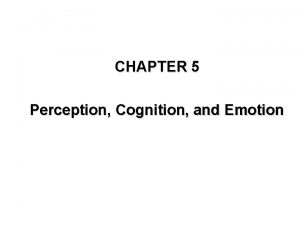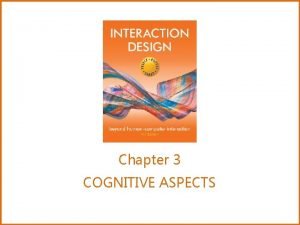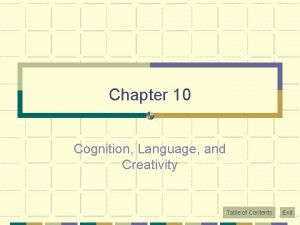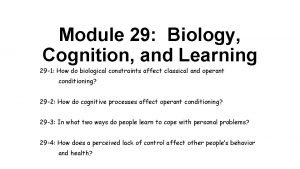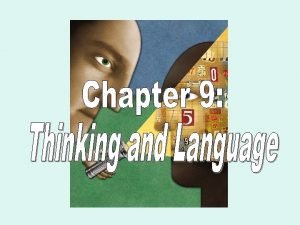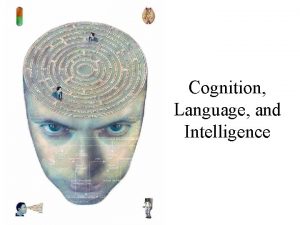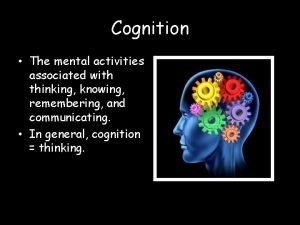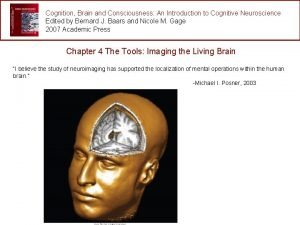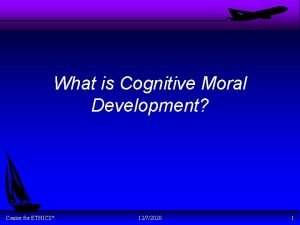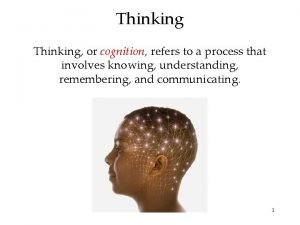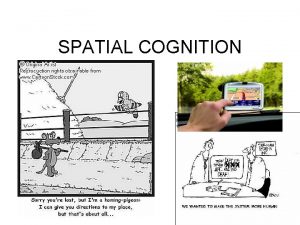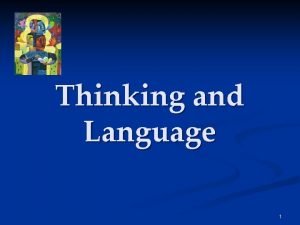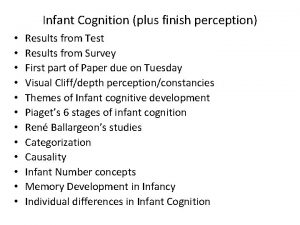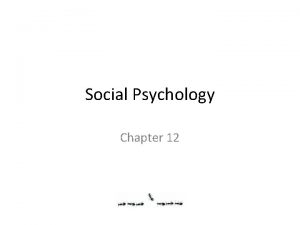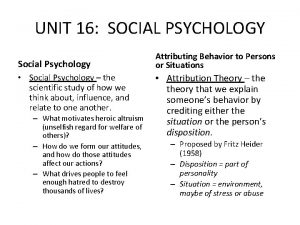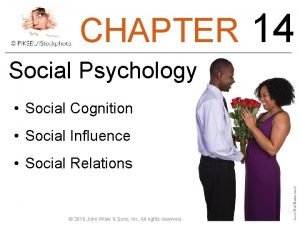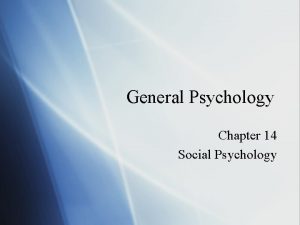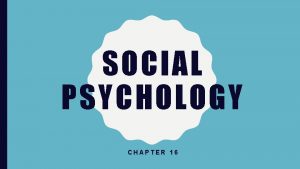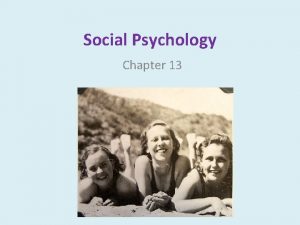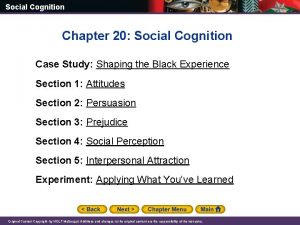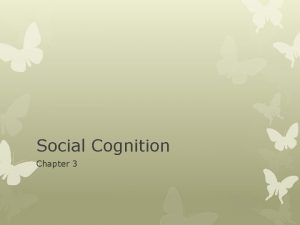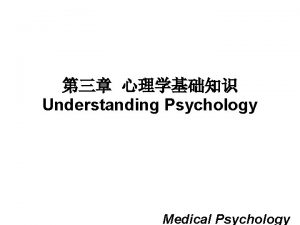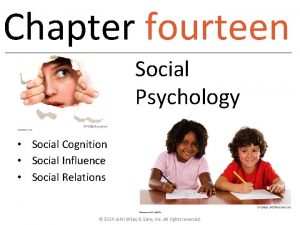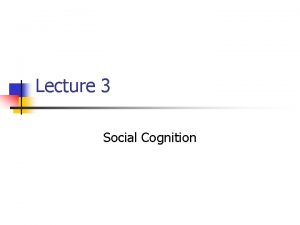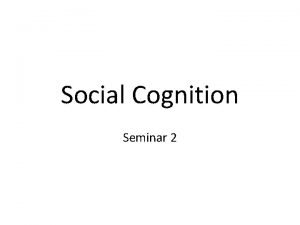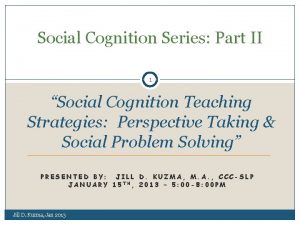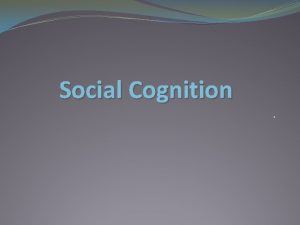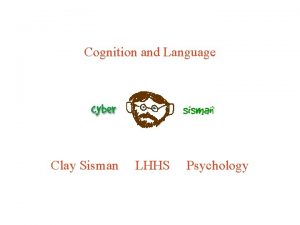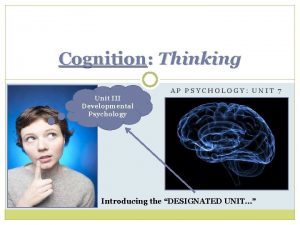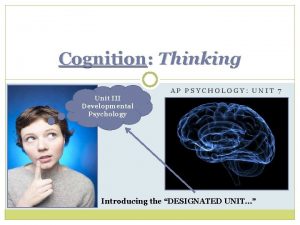SOCIAL PSYCHOLOGY UNIT 12 CHAPTER 16 SOCIAL COGNITION










































- Slides: 42

SOCIAL PSYCHOLOGY UNIT 12, CHAPTER 16

SOCIAL COGNITION: ATTRIBUTION AND COGNITIVE DISSONANCE CHAPTER 16, SECTION 1 A, PAGES 532538

SOCIAL PSYCHOLOGY • Social psychology- the branch of psychology that studies how others influence our thoughts, feelings, and actions

ATTRIBUTIONS • Attribution- the explanations we make about the causes of behavior or events – Think of the attributions you made for the highwayman scenario- who was to blame and why? • Fundamental attribution error (FAE)- a bias toward giving undue weight to personal, dispositional factors when explaining other people’s behavior and underestimating the impact of external, situational factors – Aka correspondence bias

ATTRIBUTION ERRORS AND BIASES • Saliency bias- a type of attributional bias in which people tend to focus on the most noticeable (salient) factors when explaining the causes of behavior – Example- blaming the wife in the highwayman scenario • Self-serving bias- the tendency to credit one’s own success to internal, dispositional factors, while blaming failure on external, situational factors – Example- athletes may attribute a win to their skill and a loss to a bad referee • Why? The actor-observer effect- the tendency to attribute other people’s behavior to dispositional actors, while seeing our own behavior as caused by the situation – We are the actors and know about the other factors that cause a behavior, but when we’re observing others, we may not know those factors • Culturally– Individualistic cultures focus on their own successes/failures while collectivistic may focus more on situational factors – The self-serving bias is less common in collectivistic cultures

REDUCING ATTRIBUTIONAL BIASES • Determine whether an action/behavior comes from personal factors or the situation • Ask yourself – Is the behavior unique or shared by others? – Is the behavior stable or unstable? – Was the cause of the behavior controllable or uncontrollable? • To avoid blaming the victim – What would I do in the same situation? • Maybe look first to external causes before blaming

ATTRIBUTION

EXAMPLE OF ATTRIBUTION SCENARIO

ATTITUDES • Attitude- the learned predisposition to respond positively or negatively to a particular object, person, or event – Made up of ABC: affect (feelings), behavior (actions), and cognitions (thoughts and beliefs) • Learned through direct instruction, personal experience, or watching others • Begin to form in early childhood

COGNITIVE DISSONANCE • Cognitive dissonance- the unpleasant psychological tension we experience after noticing contradictions between our thoughts, feelings, and/or actions – Leon Festinger’s theory- we need a consistency between ABCs of attitude, and when we notice an inconsistency, we experience unpleasant feelings • College students were asked to perform boring tasks, then paid $1 or $20 to tell the next participant that it was fun $1 participants reported more positive attitudes • To relieve the discomfort, we are highly motivated to change one or more of the ABC components – Even just taking a Tylenol can relieve this pain • May be only for western cultures since making a bad decision poses a threat to self-esteem more than in collectivistic cultures

SOCIAL COGNITION: PREJUDICE CHAPTER 16, SECTION 1 B, PAGES 538544

PREJUDICE • Prejudice- a learned, unjustified negative attitude toward members of a particular group – ABC components: affect (feelings), behavioral tendencies (discrimination), and cognitions (stereotypes) • Discrimination- an unjustifiable, negative action directed toward members of a group as the behavioral component of prejudice • Stereotype- an overgeneralized belief about member of a group as the cognitive component of prejudice • Prejudice includes ABC, discrimination is just the actions

COMMON SOURCES OF PREJUDICE • Learning – Primarily classical conditioning and observational learning – Example- repeated exposure to negative portrayals of people in media/TV/etc. or from parents/friends/public – Ethnocentrism is another form – May also be from operant conditioning- jokes gain attention and approval but reinforces negative attitudes/prejudices; or generalizing a negative interaction with members of a specific group • Limited resources – Prejudice leads to significant economic and political advantages to the dominant group – Prejudice can justify unequal resources

COMMON SOURCES OF PREJUDICE • Mental shortcuts – Allows us to make quick judgments to clear our mental resources for other tasks, but can lead to negative outcomes – We create ingroups (people like you) and outgroups (anyone else) – Ingroup favoritism- the tendency to judge members of the ingroup more positively than members of an outgroup • See ingroup members as more attractive, better personalities, more deserving, etc. – Outgroup homogeneity effect- the tendency to judge members of an outgroup as more alike and less diverse than members of the ingroup, which makes it easier for discrimination to happen • Implicit biases – Implicit bias- a hidden, automatic attitude that may guide behaviors independent of a person’s awareness or control – We naturally group our world but if we do so based on incorrect stereotypes, it can lead to implicit biases – Research has proven this for taxi drivers, gender effects in schools, athletes in games

REDUCING PREJUDICE • The price of prejudice- major events like the Holocaust; slavery in America and around the world; current events with racial and gender disparities in employment, wealth, education, health care; the current immigration controversy; stigma against mental illness, to name a few. • Cooperation with common goals – Cooperation rather than competition; especially with superordinate goals – Sherif’s Robbers Cave experiment- groups of boys at summer camps were separated, the experimenters set up strong ingroup and outgroup identification, then set the groups against each other in competition leading to prejudice; then mini-crises were presented where the groups had to work together and all won, result was a disappearance of prejudice • Intergroup contact – Increase contact and positive experiences between groups, even imagined contact can work – Since some contact can increase prejudice, the contact should include situations where there is close interaction, interdependence (superordinate goals that require cooperation), and equal status

SHERIF’S ROBBERS CAVE EXPERIMENT

REDUCING PREJUDICE • Cognitive retraining – Using classical conditioning to pair ideas about groups of people with pleasant terms that contradict the stereotype, like females and math – Pay selective attention to similarities between individuals and groups, not differences – Does not necessarily mean ideas like racial colorblindness • Cognitive dissonance – Meeting people who do not meet our stereotype initially say it is an exception to the rule continued contact with non-stereotypical individuals cognitive dissonance requires an attitude change (prejudice reduction) • Empathy induction – Take another’s perspective to understand sympathize with the struggles and successes of other groups – Deep canvassing experiment- having a person bring up stories/have a conversation regarding their own experience with stereotypes and prejudice, then relate it to a prejudice we are trying to reduced the prejudice

SOCIAL INFLUENCE CHAPTER 16, SECTION 2, PAGES 545553

CONFORMITY • Conformity- a change in thoughts, feelings, or actions because of real or imagined group pressure • Asch’s experiment- first demonstrated conformity in research – Participants were shown two cards like seen above. There were seven people and each had to say out loud which of the second card matched the first card. The participant was the second to last to give an answer and all others were actually confederates. Confederates gave wrong answers to give pressure to participant. – Conformity varies based on age and personality but still indicates the effects of conformity, even to changing our moral standards

WHY WE CONFORM • Normative social influence- based on the need to be liked, accepted, and approved of by others – Makes us feel good and it is adaptive to conform – This can be harmful though, following trends that are harmful to the individual – Examples: retweets, personal space, clothing, asking people to give up their seats • Informational social influence- based on the need for information and direction – Trusting information given by others or trusting that someone else must’ve had more information (Asch’s experiment) • Reference groups- any groups that individuals use as a standard for evaluating themselves – The people we admire, like, and want to resemble

OBEDIENCE • Obedience- the act of following direct commands, usually from an authority figure • We are socialized to see certain people as authority figures • Not all conformity or obedience is bad- it is often in our and others’ best interests, ensures safety, order, predictability • There are bad examples of obedience- drugs/risky behavior, following orders from military leaders that are unjust

MILGRAM’S EXPERIMENT • Procedure – Participants were told they were studying the effects of punishment on learning – Participants play the teacher the learner is strapped to an electric chair that the participant controls with switches labeled “slight shock” to “danger: severe shock” and “XXX” – The participant has to “shock” any errors made by the learner – The learner continues to make errors, leading the participant to give increasingly painful shocks – The learner was a confederate and faked the shock reactions • Stanley Milgram was looking at if participants would obey the experimenter’s prompts and commands to continue shocking the learners • 25% predicted they would go beyond 150 volts, no one predicted 300 volts 65% of participants went to 450 volts • Recent reproduction of this experiment shows 90% went to the highest level of shock, slightly more willing to shock men • Considered an unethical experiment for deception, lack of debrief, discomfort for participants, no standard procedure

UNDERSTANDING DESTRUCTIVE OBEDIENCE • Experiments like Milgram’s are helpful for understanding big and small situations: like Nazi officers and their actions (what influenced Milgram), police situations, etc. • Many factors influence obedience – – – Legitimacy and closeness of the authority figure Remoteness of the victim Assignment of responsibility Modeling or imitation of others Socialization- being taught to listen to people of authority, especially in certain fields The foot-in-the-door technique- a process in which an initial, small request is used as a setup for a later, larger request – Adherence to ideologies- seeing situations or stories that promote ideologies like taking whatever actions is necessary in times of war, etc. – Relaxed moral guard- we think that bad people look like bad people, so if they don’t, we relax our moral judgments and may not think twice about it

FACTORS OF OBEDIENCE

GROUP PROCESSES: GROUP MEMBERSHIP • Group membership- how the roles we play within groups affect our behavior • Philip Zimbardo’s experiment – Participants came to simulate prison life: they were assigned to play a guard or prisoner – Prisoners were arrested and enrolled in the normal process; guards were given uniforms and complete control – All guards eventually abused their power, sometimes at the slightest disturbance; prisoners became passive and depressed or rebelled – Stopped after six days because of the severity of the psychological changes in participants • Zimbardo’s experiment showed us a few things – How roles and situations can change behavior dramatically – Deindividuation- the reduced self-consciousness, inhibition, and personal responsibility that sometimes occurs in a group, particularly when the members feel anonymous • Increases arousal and feelings of anonymity – Explains why vandalism increases on Halloween, cyberbullying exists, crimes/riots occur at night in darkness

GROUP PROCESSES: GROUP AND INDIVIDUAL PERFORMANCE • How does the presence of others affect our performance? • Social facilitation- the tendency for an individual’s performance on an easy task to improve due to the presence of others – May reverse to diminish our performance (social impairment) • Social loafing- the tendency for individuals to exert less effort in a group due to reduced accountability and risk of detection – How much our performance is monitored and how much we are held responsible for the outcome – Can be changed by being more clear on individuals’ contributions, anonymous assignment of points, increased team identification

GROUP PROCESSES: DECISION MAKING • How do groups affect our decisions? • Risky-shift phenomenon- theory that after group discussion, groups support riskier decisions, but this has shown mixed results in research – Depends on the groups’ preexisting tendencies – Group polarization- the tendency for the decisions and opinions of group members to become more extreme (either riskier or more conservative), depending on the members’ initial dominant tendency • People pick up information that supports their opinion during group discussion • May explain why we interact with only like-minded people, get our news from sources that support our preexisting opinions, talk politics with people who agree with us • Within the legal system- it would be best but the jury does not start neutral and there is not an equal argument

GROUP POLARIZATION

GROUP PROCESSES: DECISION MAKING • Groupthink- the faulty decision making that occurs when maintaining group harmony becomes more important than making a good decision – Two most important factors- pressure for uniformity and the unwillingness to hear dissenting information – The beginnings- group members feel cohesive, removed from judgments of outsiders, directive leader, little chance for debate • To avoid groupthink – – – – Look at antecedent conditions on next slide Group leaders maybe excuse themselves from discussions Members should avoid isolation Be encouraged to voice dissenting opinions Seek advice and input from outside experts Members should generate alternatives and vote by secret ballot Group members be reminded they are held responsible for their decisions Avoid social media

GROUPTHINK

SOCIAL RELATIONS: AGGRESSION AND ALTRUISM CHAPTER 16, SECTION 3 A, PAGES 554558

AGGRESSION • Aggression- any behavior intended to cause psychological or physical harm to another individual • Biological factors – Generally reject that it is from instinct – Some may be genetically predisposed to have hostile, irritable temperaments and to engage in aggressive acts – Other factors- brain injuries, testosterone, lowered levels of some neurotransmitters, substance abuse (especially alcohol) • Psychosocial factors – Aversive stimuli (loud noise, heat, pain, bullying, insults, bad smells) – May be learned through observation, modeling, and reinforcement- growing up in an aggressive culture will develop more aggressive responses • Show in studies with reality TV and violent crime dramas • Meta- analyses show that media violence scan increase aggressive behavior and thoughts, angry feelings, desensitization, and overall physiological arousal

REDUCING AGGRESSION • Commonly misunderstood to be a method- catharsis- release impulses through harmless forms of aggression- rigorous exercise, punching a pillow, etc. – BUT may actually increase aggressive feelings, supported by Darwin’s theories • Better approach= incompatible responses – Some emotions are the opposite (incompatible with aggression), like humor or empathy engaging in acts that activate these emotions can reduce anger and frustration • From APA’s study on gun violence – Primary/universal prevention- healthy development, teaching better social and communication skills – Secondary/selective prevention- assist at-risk individuals with mentoring programs, conflictmediation services, etc. – Tertiary/indicated prevention- intensive services for individuals with a history of aggressive behavior to reduce a recurrence or escalation

ALTRUISM • Altruism- prosocial behaviors designed to help or benefit others • When and why we help – Evolutionary theory of helping- altruism is an instinctual behavior that has evolved because it favors survival of the helper’s genes – Egoistic model of helping- we help because of anticipated gain- later reciprocation, increased self-esteem, or avoidance of distress and guilt – Empathy-altruism hypothesis- we help because of empathy for someone in need • We are more likely to help someone who is going through something we have gone through

ALTRUISM: WHY DON’T WE HELP • Studies first came from the murder of Kitty Genovese- a woman who was stabbed to death while (reportedly) 38 of her neighbors heard/watched but did nothing • John Darley and Bibb Latane looked into the effects through multiple situations – A seizure heard over the phone during an interview, smoking filling the room while participants fill out a survey – Results: whether or not someone helps depends on events and decisions: the potential helper must notice what is happening, interpret the event as an emergency, accept personal responsibility for helping, decide how to help, then actually start helping

ALTRUISM: WHY DON’T WE HELP • The biggest decision is during stage three- taking personal responsibility to help • We think “someone else is helping” • Bystander effect- the greater the number of bystanders, the less likely it is than any one individual will feel responsible for seeking help or giving aid to someone who is in need of help • Diffusion of responsibility- a person is less likely to take responsibility for acting when others are present – Also relates to informational social influence (we think others have information we don’t, so we trust them)

ALTRUISM: HOW TO PROMOTE HELPING • If you are the victim – Yell, make noise, – Clarify what is happening – Look a bystander in the eye and tell them what you need help with • If you are the bystander – Notice the situation – Ask if they need help or assume it if it is a more serious situation and they cannot indicate • TV Shows: What Would You Do? And CNN Heroes • Laws that protect helpers from legal liability – Example: “Good Samaritan” laws in states regarding drug overdose

SOCIAL RELATIONS: INTERPERSONAL ATTRACTION CHAPTER 16, SECTION 3 B, 558 -564

INTERPERSONAL ATTRACTION: PHYSICAL ATTRACTIVENESS • Interpersonal attraction- our positive feelings toward another – Factors: physical attractiveness, proximity, similarity • Physical attractiveness – Attractive people are seen as more poised, interesting, cooperative, achieving, sociable, independent, intelligent, healthy, someone more likely to be voted for – Evolutionary explanation- men prefer attractive women because good looks and youth indicate good health, genes, and fertility while women prefer attractive men because of health, maturity, and resources recent research it may not have an effect – Beauty is in the eye of the beholder – Current cultural demands push for diets or surgeries to increase or decrease parts of our bodies seen to be attractive as smaller or bigger, and studies reinforce the judgments of attractiveness accordingly – Past the initial meeting, other factors play a role- charisma, humor, personality, intelligence, compassion – We also tend to pick partners whose physical attractiveness matches our own, due to the matching hypothesis and mating intelligence

INTERPERSONAL ATTRACTION: PROXIMITY • Proximity- geographic nearness/two people being in the same place at the same time – The likelihood of a friendship decreases as physical distance between people increases, even by the distance of a next door neighbor to two doors down – Mostly due to repeated exposure- familiar people become more physically attractive to us over time because of an evolutionary view- familiar stimuli is safer – Important to initial attraction, but some long distance relationships can still be maintained successfully • LDR may be successful if they participate in relational savoring • Similarity – We tend to find attractive and stay with people like us who share our ethnicity, social class, education, religion, interests, attitudes – We may even find differences unattractive – Opposites attract? Not usually- only when based on the recognition that in one or two core personality traits, that person offers something the other lacks

LOVING OTHERS • Robert Sternberg’s triangular theory of love- different stages and types of love result from three basic components- intimacy, passion, commitment – Consummate love is a combination of all three components, the only true/fullest form of love – Intimacy- emotional closeness and connectness, mutual trust, friendship, warmth, self-disclosure, forming of love maps – Passion- sexual attraction and desirability, physical excitement, a state of intense longing to be with the other – Commitment- permanence and stability, the decision to stay in the relationships for the long haul, feelings of security that go with this intention

LOVING OTHERS • Consummate love- strongest and most enduring type of love, based on a balanced combination of intimacy, passion, and commitment – If one partner has a higher or lower need for one or more of the components, compromise is needed to be successful • Romantic love- an intense feeling of attraction to another in an erotic context – May be universal, or at least near universal – Generally begins to fade 6 -30 months into a relationship, possibly because the realities of everyday start to show – Can be kept with small actions • Companionate love- a type of strong and enduring love characterized by deep trust, caring, tolerance, and friendship – Grows and develops as couples spend more time together
 Cognition ap psych definition
Cognition ap psych definition Odden and rochat
Odden and rochat Embodied cognition ap psychology
Embodied cognition ap psychology Embodied cognition ap psychology
Embodied cognition ap psychology Teacup ib psychology
Teacup ib psychology Embodied cognition ap psychology definition
Embodied cognition ap psychology definition Ap psych unit 7 part 2
Ap psych unit 7 part 2 Embodied cognition ap psychology
Embodied cognition ap psychology Group polarization in mean girls
Group polarization in mean girls Konsep ketersediaan heuristik
Konsep ketersediaan heuristik Chapter 7 cognition thinking intelligence and language
Chapter 7 cognition thinking intelligence and language Cognition thinking intelligence and language
Cognition thinking intelligence and language Fundamental attribution error ap psychology
Fundamental attribution error ap psychology Social psychology is the scientific study of
Social psychology is the scientific study of Unit xiv social psychology
Unit xiv social psychology Unit 14 reading guide social psychology
Unit 14 reading guide social psychology Module 74 attribution attitudes and actions
Module 74 attribution attitudes and actions Unit 14 social psychology
Unit 14 social psychology Definition of telegraphic speech in psychology
Definition of telegraphic speech in psychology Mental status exam example
Mental status exam example Serial 7s
Serial 7s What is cognition
What is cognition Cognition definition
Cognition definition What is cognition
What is cognition Types perception
Types perception Altered cognition in older adults is commonly attributed to
Altered cognition in older adults is commonly attributed to What is cognition
What is cognition Cognition definition
Cognition definition Module 29 biology cognition and learning
Module 29 biology cognition and learning Cognition refers to
Cognition refers to No word
No word The mental activities associated with thinking
The mental activities associated with thinking Complex cognition
Complex cognition Cognition and personalization
Cognition and personalization Moral cognition
Moral cognition Example of dissonance
Example of dissonance Hippocampus taxi drivers
Hippocampus taxi drivers Language
Language Cognition plus
Cognition plus Unit 10, unit 10 review tests, unit 10 general test
Unit 10, unit 10 review tests, unit 10 general test Social thinking and social influence
Social thinking and social influence Social thinking social influence social relations
Social thinking social influence social relations Chapter 12 social psychology
Chapter 12 social psychology

